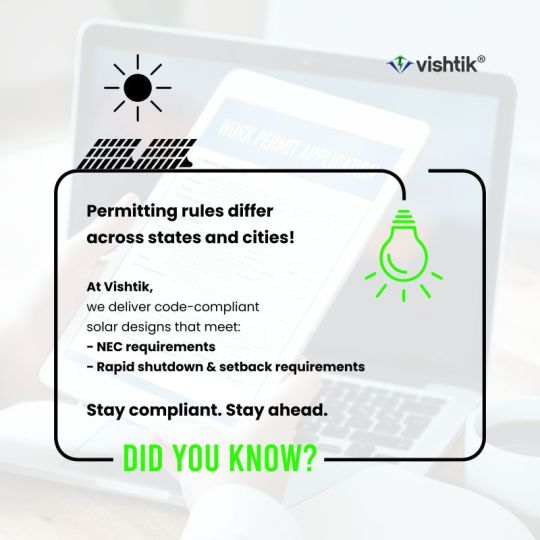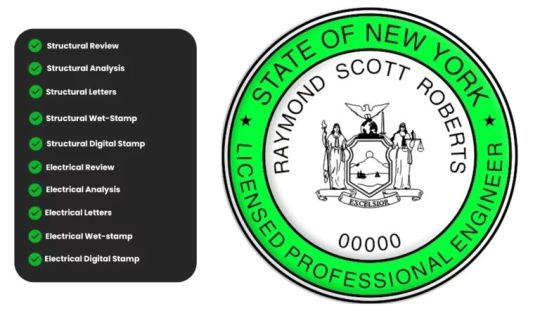#vishtiktechnologies
Explore tagged Tumblr posts
Text
Understanding the Basics of Solar Permit Design and Plan Sets

As the adoption of solar energy continues to grow, so does the need for comprehensive and accurate solar permit designs and plan sets. These documents ensure that solar installations meet all local regulations and building codes, facilitating a smooth and efficient approval process. In this blog, we will delve into the basics of solar permit design and plan sets, exploring their importance, components, and the benefits they provide to solar installers and property owners.
Introduction: The Role of Solar Permit Designs and Plan Sets
Solar energy systems must comply with numerous local building codes and regulations. A well-prepared permit design and plan set ensures that the solar installation process adheres to these standards, avoiding potential delays and complications. Understanding the fundamentals of these documents is essential for anyone involved in the solar industry, from installers to property owners.
What Are Solar Permit Designs and Plan Sets?
Solar permit designs and plan sets are detailed documents that outline the specifications and layout of a solar energy system. They are submitted to local building departments as part of the permitting process to obtain approval for the installation. These documents include everything from the system’s electrical design to structural details, ensuring that the installation is safe, efficient, and compliant with all relevant codes.
Key Components of a Solar Permit Design and Plan Set
Site Plan
Overview of the property layout
Placement of solar panels, inverters, and other components
Accessibility considerations for maintenance and emergency services
Electrical Plan
Detailed electrical wiring diagram
Specifications of electrical components, such as inverters and junction boxes
Connection to the existing electrical system and grid
Structural Plan
Load calculations for mounting systems
Roof or ground mounting details
Engineering assessments to ensure structural integrity
Safety and Compliance
Adherence to local building codes and safety standards
Fire safety measures, including clearances and pathways
Signage and labeling requirements
The Importance of Accurate and Comprehensive Plan Sets
Accurate and comprehensive plan sets are essential for several reasons:
Read More: https://vishtik.com/understanding-the-basics-of-solar-permit-design-and-plan-sets/
1 note
·
View note
Text
Residential vs. Commercial Solar Permit Design in 2025: The Ultimate Checklist

Thinking about solar in 2025? Whether you’re planning a rooftop system for a home or a large solar installation for a business, one thing’s for sure—you’ll need a proper permit design.
But here’s the catch: Residential and commercial solar permits are two completely different beasts.
That’s why we’ve put together this easy-to-follow checklist to help you understand what’s needed for each. Whether you're a homeowner, business owner, or solar contractor, this guide will help you save time, avoid headaches, and stay compliant.
Residential Solar Permit Design Checklist
If you're working on a home solar system, the permit process is usually simpler—but still very important. Here's what most building departments will want to see:
Site Plan
Basic roof layout with panels clearly marked
Distance from roof edges
Pathways for emergency access (fire code)
Property boundaries with setbacks
Structural Details
Can the roof handle the panels?
Rafter/truss spacing and material
Mounting system specifications
Sometimes you’ll need a structural letter
Electrical Plan
One-line diagram
Info on inverters and solar modules
Wire sizing and safety calculations
Point of interconnection (like your main panel)
Local Rules
Every city or county has slightly different codes
Some require HOA approvals too
Must-Have Documents
Product datasheets
Installer’s license
NEC code compliance
Homeowner-signed agreement
Commercial Solar Permit Design Checklist
When it comes to commercial solar, the rules get a lot stricter—and the documentation more technical.
Site Plan
Ground or rooftop system layout
Show all shade, obstacles, and utility easements
Mark access roads and traffic flow (if ground-mounted)
Structural Engineering
Full engineering report with PE stamp
Wind, snow, and seismic load analysis
Soil testing (for ground-mount systems)
Roof reinforcement plan if needed
Advanced Electrical Plan
Three-line diagram
Metering and load calculation
Battery integration, if applicable
Inverter string layout
Fire & Building Safety
Access pathways and setback distances
Battery and fire suppression plans
Commercial building codes
Utility & Grid Connection
Utility approval documents
Smart inverter compliance
Grid impact study (for larger systems)
Interconnection agreement
Other Required Docs
PE stamps (electrical + structural)
Liability insurance
Operations & maintenance plan
As-built drawings (after installation)
What’s New in 2025?
Solar permitting is changing fast. Here are some 2025 trends:
AI-based tools are helping designers create faster, more accurate plans
NEM 3.0 in California means battery storage is more common (especially for commercial)
E-permitting platforms like SolarAPP+ are speeding up approvals
Some AHJs are requiring detailed performance modeling for large systems
Make Permitting Easy with Vishtik
Let’s face it—permit design is one of the biggest pain points in the solar installation process. That’s where Vishtik comes in.
We offer:
Permit-ready drawings for both residential and commercial systems PE-stamped structural and electrical plans Quick turnaround times 100% AHJ-compliant designs
Whether you're a solo installer or a large EPC, Vishtik helps you stay ahead of the curve—so you can focus on building, not paperwork.
Learn more about our Permit Design Services →
Final Thoughts
Getting a solar permit doesn’t have to be a long, confusing process. When you know exactly what’s needed—and the difference between residential and commercial requirements—you’re already halfway there.
Need help with your next project? Let Vishtik take care of your permit designs from start to finish. Accurate. Fast. Reliable.
0 notes
Text
What is a Solar Site Survey and Why It's Crucial Before Installation

When it comes to installing solar panels, most people focus on equipment, costs, or savings. But there's a vital first step that determines the success of your entire system — the solar site survey. At Vishtik, we consider this on-site assessment the foundation of every solar project we deliver.
A solar site survey helps uncover the real solar potential of your property. It answers important questions like: How much sun does your roof get? Are there any shading issues? Can your electrical system handle solar integration? In short, it sets the stage for a safe, efficient, and code-compliant installation.
What is a Solar Site Survey?
A solar site survey is a professional inspection carried out at your location to evaluate the physical and technical suitability for solar panel installation. Whether it’s a residential rooftop or a large commercial setup, this step ensures your system is designed for maximum output and safety.
When you book a site assessment with Vishtik, our experts visit your property to perform detailed checks, including:
Sunlight exposure and shading analysis
Roof orientation, pitch, and space measurement
Structural integrity and load-bearing capacity
Assessment of existing electrical panels and connections
These insights help our engineering team design a solar system customized to your site conditions — not just a cookie-cutter solution.
How to Do Site Survey for Solar Installation
If you're wondering how to do site survey solar style, here’s what typically happens during the process:
Shading Check: Using advanced tools like drones or a solar pathfinder to identify obstructions (trees, nearby buildings).
Roof Measurement & Tilt Analysis: Determines panel placement, quantity, and orientation.
Photographic Documentation: For technical design and permit documentation.
Electrical System Inspection: Checks if your panel and inverter setup can safely integrate into your existing system.
Code & Permit Readiness: Ensures your site complies with local regulations before installation begins.
At Vishtik, we use this data to not only design high-performance systems but also to streamline the permitting and approval process for faster turnaround.
Why is a Site Assessment Crucial Before Solar Installation?
Skipping a site survey or relying on satellite imagery can lead to incorrect estimates, design flaws, or installation delays. Here’s why a site assessment for solar installation is absolutely essential:
Accurate System Design: Tailors the system based on real-world conditions instead of assumptions.
Avoids Structural Risks: Ensures your roof can support the weight of panels and racking.
Optimized Solar Output: Identifies the best orientation and placement to maximize sunlight capture.
Budget Accuracy: Eliminates surprise costs due to unseen site issues.
Faster Permits and Approvals: Helps meet all local utility and safety regulations the first time.
Why Choose Vishtik for Your Solar Site Survey?
At Vishtik, we go beyond standard evaluations. Our team blends cutting-edge tools with industry expertise to deliver site surveys that are detailed, accurate, and focused on long-term performance.
We serve homeowners, businesses, and contractors across the U.S., providing PE-stamped designs, structural analysis, and full solar engineering support. Whether you're just getting started or need help with permitting, our site survey service is your first step toward a seamless installation.
Conclusion
A solar site survey isn't just a box to check — it's a critical part of designing a solar system that works efficiently, safely, and legally. It helps avoid design errors, reduces costs, and ensures your installation meets local codes from day one.
Ready to Take the First Step?
Get your solar project started the right way with a professional site assessment from Vishtik. Our experienced engineers will guide you through every step — from survey to stamp to installation.
Schedule Your Solar Site Survey with Vishtik TodayAnd set your project up for long-term solar success.
0 notes
Text
Top 10 Reasons Solar Permit Applications Get Rejected (And How to Avoid Them)

Navigating the solar permitting process is often one of the most challenging stages in a solar project. A rejected application can delay timelines, increase costs, and frustrate both contractors and homeowners.
At Vishtik, we specialize in helping solar companies streamline the permitting process — ensuring faster approvals and fewer roadblocks. In this article, we break down the top 10 reasons solar permit applications get rejected — and how to avoid them for smooth, stress-free project execution.
1. Incomplete Permit Documentation
The Problem: Missing documents such as panel spec sheets, site plans, or structural details are among the top reasons for permit rejection.
Solution: Use a comprehensive checklist before submission. Vishtik’s Permit Design services ensure every submission is complete and accurate.
2. Outdated or Incorrect Plan Sets
The Problem: Old CAD files or mismatched layouts can raise red flags during review.
Solution: Always use current code-compliant templates and tools. Vishtik ensures your drawings align with the latest local standards.
3. Non-Compliance with Local Building Codes
The Problem: What passes in one jurisdiction may get rejected in another due to different AHJ requirements.
Solution: Rely on a team familiar with nationwide permitting nuances. Our experts ensure Permit Design submissions meet local codes across all states.
4. Missing PE Stamp When Required
The Problem: Jurisdictions often require structural or electrical plans to carry a Professional Engineer (PE) stamp.
Solution: Vishtik provides quick and accurate PE Stamp services to ensure compliance and approval.
5. Lack of Structural Load Calculations
The Problem: Without detailed roof load calculations, your project might not move forward.
Solution: We include stamped structural analysis where needed, eliminating guesswork and delays.
6. Incorrect Equipment Configuration
The Problem: Incompatible panel-inverter setups or incorrect sizing lead to safety concerns and permit denial.
Solution: Our engineers double-check every system layout for performance, safety, and compliance.
7. Missing Electrical Labels or Diagrams
The Problem: NEC-mandated labels and detailed diagrams are essential for approval.
Solution: Vishtik’s templates follow national standards to avoid costly mistakes.
8. No Pathway to PTO (Permission to Operate)
The Problem: If your design doesn't show how the system connects to the grid, utilities may reject it.
Solution: Our PTO Services ensure every system is designed with a clear utility interconnection path.
9. Fire Code Violations
The Problem: AHJs require setbacks and rooftop pathways for fire safety. Missing this detail often leads to rejections.
Solution: Vishtik’s plans always factor in fire code-compliant setbacks based on your AHJ’s requirements.
10. Formatting Errors or Inconsistent Data
The Problem: Typos, mismatched information, or unprofessional formatting can derail your application.
Solution: Every Vishtik submission goes through a multi-level QA process for quality and consistency.
Avoid Costly Delays — Let Vishtik Help You Get Approved the First Time
Most solar permit rejections are avoidable — if you know what to look for and partner with the right team.
At Vishtik, we combine technical expertise with deep regulatory knowledge to help solar professionals:
Get permits approved faster Reduce rework and project delays Ensure code compliance across all 50 states
Ready to streamline your permitting process?
Let’s take the guesswork out of solar permits.
Contact Vishtik for end-to-end Permit Design, PE Stamp, and PTO Services that get approved the first time.
0 notes
Text
How to Speed Up Your Solar Permit Design in the USA – Without Compromising Quality

In the rapidly expanding solar industry, time is money. Solar companies across the United States are under increasing pressure to deliver fast, accurate, and compliant designs without sacrificing quality. One of the biggest bottlenecks? Solar permit design USA requirements. The good news: with the right approach, you can streamline your permitting process and get your PE stamped plans USA ready faster—without cutting corners.
Why Solar Permit Design Takes Time
Each U.S. jurisdiction has different requirements for solar permits. From single-line diagrams and site plans to structural and electrical calculations, solar installers need to ensure every component meets code before submission. This complexity, coupled with engineer review time, can delay installation schedules and increase project costs.
5 Proven Strategies to Speed Up Your Solar Permit Design in the USA
1. Use a Standardized Design Template
Create a base template for your projects based on previous successful submissions. Standardizing the layout, design elements, and language helps reduce time spent on each project and ensures consistency. A good solar permit design USA template can save hours in design time.
2. Work with Specialized Solar Engineering Teams
Partnering with an experienced solar engineering firm can significantly reduce turnaround time. These teams specialize in PE stamped plans USA and understand local AHJ (Authority Having Jurisdiction) requirements. Their expertise ensures your designs are both fast and compliant.
3. Leverage Design Automation Tools
Modern design tools allow solar companies to automate parts of the design process. From layout software to code calculators, these tools help reduce human error and speed up drafting. Many firms offer solar CAD services tailored for solar permit design USA, cutting the time to delivery in half.
4. Plan for AHJ-Specific Requirements Early
Before starting a design, collect information about the local AHJ's specific permitting process. Knowing the exact documentation, setback rules, and format requirements in advance allows your team to design accurately the first time—eliminating back-and-forth delays.
5. Request PE Stamping Concurrently
If your design is finalized, don’t wait to submit it for engineering review. Working with a team that can deliver PE stamped plans USA in 24–48 hours means you can move to submission quickly. Some services even offer same-day turnaround for residential solar projects.
Common Mistakes That Slow Down the Process
Submitting incomplete design sets
Ignoring local code updates
Using outdated structural calculations
Waiting until the end to engage a licensed engineer
Avoiding these issues can save both time and money during your solar permit design USA process.
Fast Doesn’t Mean Low Quality
It’s a common misconception that speeding up the process leads to lower quality. In reality, the right process, tools, and team can enhance both speed and accuracy. A well-executed PE stamped plans USA package not only gets AHJ approval faster but also boosts customer trust and satisfaction.
Conclusion
As the U.S. solar market grows, efficiency is no longer optional—it's a competitive advantage. By streamlining your solar permit design USA process and partnering with experts for PE stamped plans USA, you can reduce delays, lower costs, and deliver better service to your customers. The faster you move, the more projects you complete—without ever compromising quality.
Ready to Accelerate Your Permit Design Process?
At Vishtik Technologies, we specialize in fast, accurate, and fully compliant solar permit design USA services. Our team delivers PE stamped plans USA within 18–24 hours, tailored to your jurisdiction’s requirements.
Fast Turnaround AHJ-Approved Designs Structural & Electrical PE Stamping Residential + Commercial Projects
Contact us today at www.vishtik.com or email [email protected] to get started!
0 notes
Text
Top 10 Reasons Solar Permit Applications Get Rejected (And How to Avoid Them)

Submitting a solar permit application can feel like crossing a bureaucratic minefield. For solar installers and EPCs, permit rejections delay projects, hurt client satisfaction, and cost real money. But most solar permit rejections stem from avoidable mistakes—many of which can be fixed with the right strategy.
In this guide, we’ll break down the top 10 reasons solar permit applications get rejected—and how you can get your solar permit approved the first time.
1. Incomplete Permit Documentation
One of the most common causes of solar permit rejection is missing documents or incomplete forms. Local jurisdictions typically require detailed site plans, electrical diagrams, spec sheets, and compliance checklists.
Avoid It: Double-check the submission requirements of the Authority Having Jurisdiction (AHJ). Use a standardized checklist to ensure all documents are complete.
2. Incorrect Site Plans
Site plans must be accurate, scaled correctly, and include key property elements. Inaccuracies or outdated data can lead to rejection.
Avoid It: Use updated satellite imagery or onsite assessments. Rely on experts in permit design to prepare accurate layouts.
3. Structural Calculation Errors
Incorrect load calculations can trigger rejections, especially for rooftop solar systems.
Avoid It: Get a certified PE Stamp from a structural engineer. Proper calculations ensure your system meets wind, snow, and seismic requirements.
4. Electrical Design Issues
Poorly designed single-line diagrams (SLDs) can lead to automatic rejections. Common mistakes include wrong wire sizing, missing disconnects, or improper grounding.
Avoid It: Use qualified engineers with experience in solar electrical design. Check for NEC (National Electrical Code) compliance before submission.
5. Non-Compliance with Local Codes
Each jurisdiction has unique code requirements. Failing to meet them is a guaranteed reason for rejection.
Avoid It: Stay updated on building, fire, and electrical codes specific to your project location.
6. Missing Manufacturer Spec Sheets
Missing datasheets for panels, inverters, or racking systems can result in a denial.
Avoid It: Always include current manufacturer spec sheets. Label and organize them clearly in your submission.
7. Poor Drawing Quality
Illegible, unscaled, or unprofessional drawings can trigger red flags during review.
Avoid It: Ensure high-quality drawings with clean linework and readable annotations. Export files in high resolution with proper layering.
8. Inadequate Fire Code Compliance
Fire departments often require rooftop access and clearance areas.
Avoid It: Familiarize yourself with local fire code setbacks and integrate proper pathways into your design.
9. Improper Labeling or Signage
Failure to show required labels and signs—such as rapid shutdown warnings or equipment disconnects—can result in rejection.
Avoid It: Follow NEC and AHJ label requirements. Include them visually in the plan set with proper references.
10. Missing PE Stamp
In many cases, a licensed professional engineer’s stamp is required on structural or electrical plans.
Avoid It: If your AHJ mandates it, secure a certified PE stamp before submission. This adds professional credibility and technical validation to your application.
Conclusion: Get Your Solar Permit Approved Faster
Navigating the solar permitting process doesn’t have to be frustrating. With attention to detail and the right partners, you can eliminate the common reasons for solar permit rejection. The key lies in proactive planning, technical accuracy, and local code expertise.
At Vishtik, we specialize in end-to-end support—from permit design to PE stamping to final PTO approval. Our team of over 150 certified engineers ensures your application is complete, accurate, and code-compliant—guaranteeing faster approvals and fewer headaches.
Don’t Let Paperwork Delay Your Project
Partner with Vishtik for fast, reliable, and compliant solar permit documentation.
0 notes
Text
PE Stamps Explained: Why They’re Critical for Solar Projects in 2025

As solar adoption accelerates across the United States, the demand for code-compliant, professionally engineered solar permit packages is on the rise. One critical element in this process is the PE stamp — short for Professional Engineer stamp. Yet, many solar contractors and installers remain unclear about when, why, and how a PE stamp is required.
In this article, we’ll break down the essentials of PE stamps for solar, the 2025 updates you need to know, and how you can streamline your permitting process with the right engineering support.
What Is a PE Stamp for Solar?
A PE stamp is a professional endorsement from a licensed engineer who certifies that a solar design meets local and national building codes, structural standards, and safety regulations. For rooftop solar and ground-mounted systems alike, this stamp is often a mandatory requirement by local Authorities Having Jurisdiction (AHJs).
The PE stamp gives officials confidence that your system is:
Structurally sound
Electrically compliant
Safe for installation and operation
Why PE Stamps Are Becoming More Important in 2025
With increasing solar installations and evolving code requirements, solar PE stamp regulations have become more stringent. In 2025, many jurisdictions have updated their review processes to require PE stamps on a broader range of projects, including:
Commercial rooftop systems over a certain kW threshold
Residential solar installations in high-wind or snow load zones
Battery backup and energy storage integrations
Ground-mounted systems requiring civil or structural engineering analysis
In short, PE stamps are no longer a “nice-to-have” — they are a must-have in many regions.
PE Review Requirements: What AHJs Are Looking For
Every PE review involves a careful analysis of your solar project’s structural and electrical plans. Some common components that engineers evaluate include:
Roof loading and mounting system design
Wind uplift calculations
Electrical wiring, disconnects, and interconnection diagrams
Compliance with NEC (National Electrical Code) and IBC (International Building Code)
Fire setbacks and rapid shutdown compliance
Failure to meet PE review requirements can delay your project, lead to permit rejections, or even result in costly redesigns.
How to Simplify the PE Stamp Process
Many contractors struggle with PE stamp requirements simply because they lack the time or in-house expertise to manage the engineering process. That’s where working with a specialized solar engineering service comes in.
Here’s what to look for:
State-licensed engineers who can provide PE stamps in your project’s jurisdiction
Fast turnaround times for quick permitting
Expertise in solar-specific structural and electrical designs
A partner who understands local AHJ expectations
At Vishtik Technologies, we help solar contractors across the U.S. get fast, accurate, and compliant PE stamps for every type of solar project.
Conclusion
As the solar industry becomes more regulated in 2025, engineering stamp solar requirements are more important than ever. PE stamps not only ensure your solar designs meet safety and code standards but also help avoid costly delays and rework during permitting.
Contractors who stay ahead by partnering with reliable engineering professionals will be best positioned to scale confidently and compliantly. Whether you’re working on residential rooftops or large-scale commercial arrays, don’t leave PE compliance to chance.
Ready to take the stress out of permitting? Explore our PE Review & Stamp services and ensure every project is designed right — the first time.
0 notes
Text
How to Get AHJ Approval for Your Solar Permit in 2025: A State-by-State Guide

In the solar industry, getting timely AHJ (Authority Having Jurisdiction) approval is one of the most critical — and often most delayed — steps in the installation process. Whether you’re a solar installer handling dozens of projects a month or a contractor expanding across states, understanding how AHJ approval works can save you time, money, and customer frustration.
In this guide, we’ll walk you through how to approach AHJ requirements in 2025, what documents are essential, and how Vishtik’s permit design services help streamline approvals across all 48 states.
What is an AHJ in Solar Permitting?
An AHJ (Authority Having Jurisdiction) is the local government agency or department responsible for reviewing and approving your solar project plans. They enforce building, electrical, fire safety, and zoning codes.
AHJs vary by city, county, and state — which means every solar permit may face different rules, turnaround times, and required documents.
Common Documents Required by AHJs
Most AHJs require a combination of the following documents for solar permit approval:
Site Plan / Roof Plan
Electrical Line Diagram
Equipment Specification Sheets
Structural Load Calculations
Professional Engineer (PE) Stamp (if applicable)
Fire Setbacks & Access Pathways
Utility Interconnection Agreement
Compliance with NEC & IBC codes
State-by-State Insights for AHJ Approval (2025)
California
Known for stringent fire and structural codes.
AHJs typically require fire setback diagrams, rapid shutdown compliance, and Title 24 documents.
Average approval time: 5–15 business days.
Texas
Varies significantly by county.
Structural letters and PE stamps are often required.
Some rural areas have no permitting requirements at all.
Average approval time: 3–10 business days.
Florida
Wind load and hurricane zone compliance is crucial.
AHJs often require specific mounting and anchoring specs.
PE-stamped structural letters are almost always needed.
Average approval time: 5–12 business days.
New York
Dense permitting regulations in NYC boroughs.
Often requires DOB (Department of Buildings) submissions.
Rapid shutdown and ConEd interconnection paperwork required.
Average approval time: 10–20 business days.
Arizona
Many AHJs follow the 2017/2020 NEC.
Easier for standard residential rooftop systems.
Some municipalities allow over-the-counter approvals.
Average approval time: 2–7 business days.
Note: Vishtik supports permit design and AHJ approval assistance across 6,856+ AHJs and 48 U.S. states.
How Vishtik Simplifies AHJ Approvals
At Vishtik, we specialize in high-accuracy, AHJ-compliant solar permit design with a 99.8% first-time approval rating. Here’s how we help you win time and efficiency:
Custom Designs Based on Local Codes Our system auto-detects AHJ requirements and formats permit sets accordingly.
PE-Stamped Letters Within 5 Hours We provide structural and electrical PE stamps in hours, not days.
12-Hour Turnaround on Most Permit Sets We prioritize speed without compromising quality.
Dedicated AHJ Research Team Our experts track updates from thousands of jurisdictions, ensuring your permit is always code-compliant.
Pro Tips to Get Faster AHJ Approval
Know Your Local Codes — Always reference the latest NEC, fire, and zoning codes in your design.
Use Standard Equipment — AHJs are more comfortable approving well-known brands and mounting systems.
Submit Complete Packages — Incomplete submissions cause most delays.
Track Your Application — Follow up regularly, especially in states like NY or CA.
Work with Experts — Partner with companies like Vishtik who’ve submitted 15,000+ designs and understand every nuance.
Conclusion
Whether you’re installing in Florida or Fresno, navigating AHJ requirements is a crucial skill for any solar professional in 2025. With regulations tightening and demand increasing, partnering with a seasoned design provider like Vishtik can eliminate bottlenecks and speed up project timelines.
Need help with your next permit set? Let Vishtik handle the compliance, so you can focus on installs. Visit www.vishtik.com to get started.
0 notes
Text

At Vishtik Technologies, our solar permit designs strictly follow NEC code requirements, ensuring safety, reliability, and fast approvals. Code-compliant designs mean peace of mind—for installers and homeowners alike.At Vishtik Technologies, our solar permit designs strictly follow NEC code requirements, ensuring safety, reliability, and fast approvals. Code-compliant designs mean peace of mind—for installers and homeowners alike.
Sign Up Now: http://project.vishtik.com Call us: +1 (307) 800-0424
#NECCode#SolarPermitDesign#CodeCompliant#SolarEngineering#VishtikTechnologies#SolarExperts#CleanEnergy#SolarDesign#PermitReady#SafeSolarActivate
0 notes
Text
PE stamp for solar projects

Vishtik offers the fastest and most cost-effective solutions for structural letters, PE stamps, and post-installation letters
Trust Vishtik’s PE stamp for solar projects Service for meticulous assessment and certified stamps ensuring structural and electrical integrity. Our expert evaluation streamlines approval processes for your projects’ success.
Read More: https://vishtik.com/pe-stamp/
For More Details Contact Us:
+1 (307) 363- 9738
0 notes
Text
PE stamp for solar projects

Vishtik offers the fastest and most cost-effective solutions for structural letters, PE stamps, and post-installation letters
Trust Vishtik’s PE stamp for solar projects Service for meticulous assessment and certified stamps ensuring structural and electrical integrity. Our expert evaluation streamlines approval processes for your projects’ success.
Read More: https://vishtik.com/pe-stamp/
For More Details Contact Us:
+1 (307) 363- 9738
0 notes
Text
Solar Permit Design

98% First Pass Review Rate
Maximize efficiency and cost-effectiveness with Vishtik’s Solar Permit Design—delivering swift, comprehensive designs, engineering expertise, and guaranteed AHJ compliance at competitive rates, all within 12 hours.
Read More: https://vishtik.com/solar-permit-design-2/
For More Details Contact Us:
+1 (307) 363- 9738
0 notes
Text
Solar Sales Proposal

Get the Maximum Impact
Get a Solar Sales proposal with personalized, permit-quality accuracy with just an address and an electric bill. Your customers get a premium experience and you save time. Read More: https://vishtik.com/solar-sales-proposal/
For more details contact us:
+1 (307) 363- 9738
0 notes
Text
Simplifying Solar Permitting in Rhode Island: What You Need to Know

Introduction
Navigating the permitting process for solar installations can often be a daunting task for homeowners and businesses alike. Rhode Island has taken significant steps to streamline this process, making it easier for applicants to secure the necessary permits for their solar photovoltaic (PV) systems. In this blog post, we’ll break down the key elements of Statewide Solar Permitting in Rhode Island, providing you with everything you need to know to get started with your solar project.
Purpose of the Regulations
The primary goal of Rhode Island’s solar permit regulations is to create a predictable and universal process for obtaining a single permit that covers both building and electrical aspects of solar PV systems. This streamlined approach not only simplifies the application process but also ensures that applicants can efficiently navigate municipal requirements without unnecessary delays.
Authority and Scope
These regulations are issued by the Rhode Island Office of Energy Resources in collaboration with the Rhode Island State Building Code Commission. As of January 1, 2018, all municipalities in Rhode Island are required to use the standardized statewide solar energy permit application, ensuring consistency and predictability across the state.
Key Definitions:
Understanding the terminology used in the permit application process is crucial. Here are some essential definitions:
Alternating Current (AC): A type of electrical current where the direction is reversed at regular intervals or cycles.
Direct Current (DC): A type of electrical transmission where electricity flows in one direction, usually at low voltage and high current.
Inverter: A device that converts DC electricity from solar panels into AC electricity that can be used by the electrical grid.
Solar Photovoltaic System (PV System): An arrangement of solar panels, inverters, and other components that generate and convert solar energy into usable electricity.
Components of the Statewide Solar Energy Permit Application:
The application requires detailed information and documentation to ensure that all aspects of the solar installation are adequately addressed. Here are the main elements you’ll need to include:
Property Owner Information: Name and address of the property owner and the installation site.
System Details: Total system size (AC and DC), interconnection location, and mounting structure.
Energy Storage: Information on any energy storage components, including their use and charging method.
Contractor Details: Business name, address, and license numbers of the applicant and electricians involved in the installation.
Roofing Information: Existing roofing material and methods for weatherproofing roof penetrations.
Structural Details: Engineering and design specifics of the mounting structure, including certification from a Rhode Island professional engineer.
Read More: https://vishtik.com/simplifying-solar-permitting-in-rhode-island-what-you-need-to-know/
0 notes
Text
Revolutionize Your Solar Sales with a Dedicated Call Center

In the dynamic world of solar sales, where every lead counts, having a dedicated call center can be a game-changer. Solar companies often face challenges in reaching out to potential customers, managing appointments, and ensuring a smooth sales process. A well-structured call center can address these challenges and significantly boost your sales efforts.
Why a Call Center Matters in Solar Sales
Lead Generation: A call center can efficiently generate leads through outbound calls, reaching out to potential customers who have shown interest in solar energy. This proactive approach ensures a steady flow of qualified leads.
Appointment Setting: Setting appointments with potential customers can be time-consuming. A call center streamlines this process, ensuring that appointments are scheduled promptly and efficiently.
Customer Outreach: Regular follow-ups and customer outreach are crucial in solar sales. A call center can manage these interactions, keeping your brand at the top of customers’ minds.
Efficient Sales Process: A dedicated call center ensures that your sales team can focus on closing deals, rather than spending time on administrative tasks.
Scalability: As your business grows, so do your sales needs. A call center can scale up its operations to meet the increasing demands, ensuring that you never miss out on potential sales opportunities.
Key Components of a Successful Solar Sales Call Center
Advanced Dialing Technology: Utilizing predictive dialers can increase the efficiency of your call center, ensuring that your agents spend more time talking to prospects and less time dialing numbers.
Quality Control Measures: Implementing robust quality control measures ensures that all interactions with customers are of the highest standard, leading to better customer satisfaction and increased sales.
Comprehensive Training Program: A well-trained sales team is crucial for the success of your call center. Providing comprehensive training programs ensures that your agents are well-equipped to handle customer queries and objections effectively.
Integration with CRM Systems: Seamless integration with CRM systems ensures that all customer interactions are recorded and tracked, providing valuable insights for your sales team.
Regular Performance Monitoring: Monitoring the performance of your call center ensures that you can identify and address any issues promptly, leading to improved efficiency and better results.
Read More: https://vishtik.com/revolutionize-your-solar-sales-with-a-dedicated-call-center/
0 notes